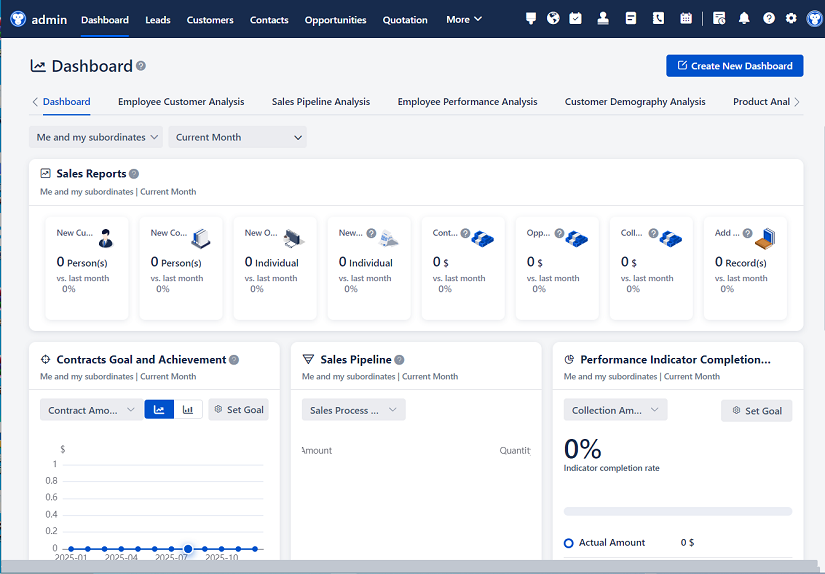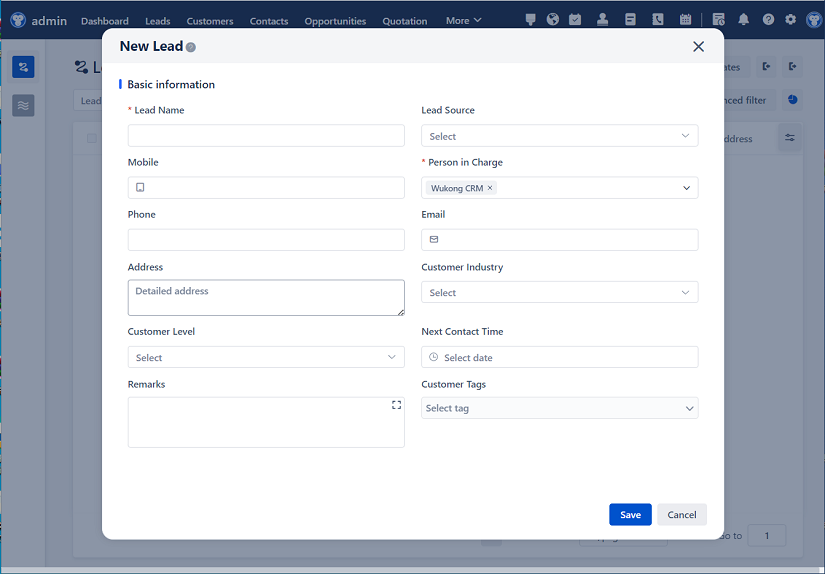
△Click on the top right corner to try Wukong CRM for free
So, let me tell you something — if you're running a business, big or small, and you're still managing customer relationships with spreadsheets or sticky notes, you're probably working way harder than you need to. I’ve been there. I remember trying to keep track of client follow-ups in a messy Excel file, only to realize I missed an important email because it got buried under three other tabs. It was frustrating, and honestly, kind of embarrassing when the client followed up and I had to scramble.
That’s when I started looking into CRM systems — Customer Relationship Management tools. At first, I thought, “Oh, this is just for big corporations with fancy tech teams.” But guess what? There are CRMs out there for every kind of business, from solopreneurs to enterprise-level companies. The real challenge, though, isn’t just picking one — it’s figuring out which one actually fits your budget and your actual needs.
Let me break it down for you, because I know how overwhelming this can be. I spent weeks comparing different CRM platforms, reading reviews, watching demo videos, and even signing up for free trials. And honestly, not all of them lived up to the hype. Some were too complicated, others didn’t have the features I actually needed, and a few just felt like they were charging way too much for what they offered.
So, here’s what I learned — and what I wish someone had told me earlier.

First off, pricing models vary a lot. Some CRMs charge per user per month, others have tiered plans based on features, and a few even offer flat-rate pricing no matter how many people are on your team. That last one sounds great, right? But then you realize it might not include advanced automation or integrations unless you pay extra. So, always read the fine print.
Let’s talk about some of the big names. Salesforce — yeah, that one. Everyone’s heard of it. It’s powerful, no doubt. But here’s the thing: it can get expensive, fast. Their basic plan starts around
Then there’s HubSpot. I really liked HubSpot because they have a free version — yes, free! It’s actually pretty solid for small businesses just getting started. You can manage contacts, track emails, and even run basic campaigns. But as your business grows, you’ll probably need to upgrade. Their paid plans start around $45 per month, and while they’re packed with marketing, sales, and service tools, some people find the interface a bit cluttered after a while.
Zoho CRM is another one that surprised me. It’s affordable — like, really affordable. Their basic plan is around $14 per user per month, and even their higher tiers don’t break the bank. Plus, they’ve got a ton of integrations and customization options. I was skeptical at first because it’s not as flashy as some others, but after using it for a few months, I realized it does exactly what I need without all the fluff.
Then there’s Pipedrive. If you’re all about visual sales pipelines, this one’s for you. It’s super intuitive, especially if your sales process is straightforward. Pricing starts at about $15 per user per month, and it scales up depending on automation and reporting features. I liked how clean and focused it was — no distractions, just the tools to move deals forward.
But here’s the thing — price isn’t everything. I made the mistake once of going for the cheapest option, only to realize it didn’t integrate with my email or calendar. That meant double data entry, which defeated the whole purpose of using a CRM. So, always check compatibility with the tools you already use — like Gmail, Outlook, Slack, or your e-commerce platform.
Another thing people don’t talk about enough is onboarding and support. Some CRMs offer great onboarding — like live training sessions or setup assistance — while others just drop you into the system and say, “Good luck!” I went with one platform that had amazing features but zero hand-holding, and I wasted hours trying to figure out how to import my contacts properly. Not fun.
And let’s not forget mobile access. I’m on the go a lot, so being able to update a client note from my phone is a game-changer. Most CRMs have mobile apps now, but not all of them are created equal. Some feel clunky or missing key functions. Test the app before committing — seriously, do it.
Now, here’s a tip: don’t just look at the monthly price. Think long-term. Will this CRM grow with your business? Can you add more users easily? What happens if you need more storage or advanced reporting down the road? I once picked a CRM that seemed perfect at the time, but six months later, when I hired two more team members, the cost doubled — and I wasn’t ready for that.
Also, watch out for hidden fees. Some platforms charge extra for things like phone support, API access, or exporting your data. That’s a red flag for me. Your data should be yours, no extra charge. And if they make it hard to leave, that’s a sign they’re more interested in keeping you locked in than actually helping you succeed.
So, how do you pick the right one? Start by asking yourself a few simple questions. What do you actually need? Are you focused on sales? Marketing automation? Customer service? Maybe all three? Be honest about your priorities. If you’re a small team just trying to keep track of leads, you don’t need a $200-per-user enterprise system.
Then, set a realistic budget. Don’t just pick the cheapest option — think about value. How much time will this save you? How many missed opportunities could it prevent? I calculated that my current CRM saves me at least 10 hours a month on admin work. That’s like getting an extra part-time employee for less than $50 a month. That’s a no-brainer.
Next, take advantage of free trials. Almost every CRM offers one — usually 14 to 30 days. Use that time wisely. Don’t just click around — actually input real data, test workflows, and involve your team. See how it feels in real life, not just in a sales demo.

And speaking of your team — get their input. If you’re the only one using the CRM, great. But if others need to adopt it too, make sure it’s user-friendly. I once chose a CRM that I loved, but my sales team hated it because it was too slow and complicated. We ended up switching six months later, which was a waste of time and money.
Integration is another big one. Does it connect with your email? Your calendar? Your website forms? Your accounting software? The more seamless the integration, the less manual work you’ll have to do. I use a CRM that syncs with Gmail and my calendar automatically — I can log calls, schedule follow-ups, and track emails without ever leaving my inbox. That kind of efficiency is worth paying a little extra for.

Security matters too. You’re storing customer data — names, emails, maybe even payment info. Make sure the CRM uses encryption, has regular backups, and complies with privacy regulations like GDPR or CCPA. Don’t just assume they’re secure — ask.
And finally, think about customer support. What happens when something goes wrong? Is there a help center? Live chat? Phone support? I had a situation where a sync failed and I lost a day’s worth of notes. I panicked — but the support team got it fixed in under an hour. That kind of reliability is priceless.
So, after all that research and trial and error, here’s my personal recommendation: start simple. Don’t overcomplicate it. Use a free or low-cost CRM to get the basics down. Then, as your business grows, upgrade to something more robust. And always, always read the reviews — especially the negative ones. They’ll tell you things the sales page won’t.
At the end of the day, a CRM should make your life easier, not harder. It should help you build better relationships, close more deals, and stop wasting time on busywork. If it’s not doing that, it’s not the right fit — no matter how cool the features look on paper.

I hope this helps you avoid some of the mistakes I made. Choosing a CRM doesn’t have to be stressful. Take your time, do your homework, and trust your gut. You’ve got this.
FAQs (Frequently Asked Questions)
Q: Can I switch CRMs later if I don’t like the one I choose?
A: Absolutely. Most platforms let you export your data, and many even offer migration tools to help you move smoothly. Just make sure you back up everything first.
Q: Is a free CRM good enough for a growing business?
A: It depends. Free CRMs like HubSpot’s free plan are great for startups or solopreneurs. But as you add more contacts and team members, you’ll likely need paid features for automation, reporting, and integrations.
Q: Do I need to pay for training?
A: Not always. Many CRMs offer free onboarding resources, video tutorials, and community forums. Some higher-end platforms include live training in their premium plans.
Q: What if my team resists using the CRM?
A: That’s common. Get them involved early, show them how it saves time, and start with simple workflows. Make adoption part of your team culture — maybe even add a little friendly competition.
Q: Are cloud-based CRMs safe?
A: Yes, most reputable CRMs use strong encryption and security protocols. Just make sure to use strong passwords and enable two-factor authentication.
Q: Can I customize the CRM to fit my sales process?
A: Most modern CRMs allow some level of customization — like adding custom fields, stages, or automations. Check the platform’s flexibility before committing.
Q: How many users do I need to start?
A: You can usually start with just one user and add more as you grow. Most platforms charge per user, so keep that in mind when budgeting.
Q: Will a CRM really save me time?
A: From my experience — yes, definitely. Automating follow-ups, logging interactions, and tracking deals all in one place cuts down on admin work and helps you focus on selling.
Related links:
Free trial of CRM
Understand CRM software
AI CRM Systems

△Click on the top right corner to try Wukong CRM for free